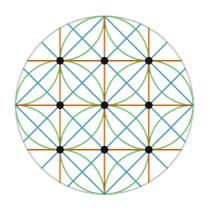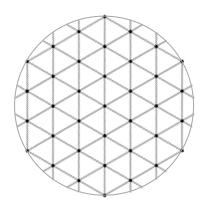Hittite sun discs
To get convinced of the Near East Bronze Age origin of the geometrical ideas of squares and equilateral triangles, we can take a look at the Pre-Hittite religious standards. Excavations started in the 1910s by a German archaeology team in Alacahöyük1, central Turkey, and later continued by a Turkish team whose work was personally funded by Mustafa Kemal Atatürk, revealed objects known as the Hittite Sun.


These objects are visible in the Anatolian Civilization Museum, Ankara, Turkey. Eventually, the Hittite Sun symbol became the emblem of Ankara University itself.
Dating of the objects goes back to the Pre-Hittite civilization called Hattusa during the Early Bronze age, around 2500 BC. Again, there are no written texts telling the meaning of the discs. The earliest mentions of Hattis and their history comes from later Hittite sources in the second millennium BC. The most apparent motif in the Hittite Sun disc is a bull symbol that has symmetrical horns. This is imitated on many other related objects2 found from the archaeological site. The disc as a symbol of the Sun looks like the most suitable association. Sometimes a half crescent disc above the head of the bull was also symbolizing the Moon.
But what interests us the most, is the geometrical formation inside the disc. The most famous Hittite sun disc standard seems to get its form from the square lattice model, which in turn can be found in the Cownose model as described below.



Other, although not so famous, Hittite sun disc contains a hexagonal grid, which can be found from the overlapping circles model, the Flower of Life, as presented below.



A nearly perfect round shape of the first disc indicates that the circular form was intentional. Maybe aging and rust have distorted the exact formation of the latter hexagonal disc, or the formation exceeded the skills of the Bronze Age blacksmith. In any case, I think it is notable that these two formations based on the square root of 2 and the square root of 3 geometry co-existed so early and also, in this case, the square root of 2 formation is far more common.
Of the several dozens of sun disc standards, I have found that only the above is following a hexagonal pattern. If the model that was used to form the latter disc was based on the overlapping circles, then it would be the earliest perfect FOL (class 3) available. Yet, the exact date of the FOL in Abydos still remains unconfirmed and could change this fact. If the overlapping circles model was used, indeed, it would mean that the FOL was known both in Indus valley and in Hattusa in the middle of the third millennium BC.
To get more textual data for investigation we need to move from the Bronze Age to the second and to the first millennium BC. My particular interest here is to examine some Semitic and Greek tales and mytho-religious accounts, which may relate to the FOL symbolism.